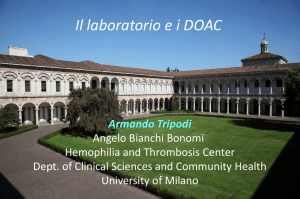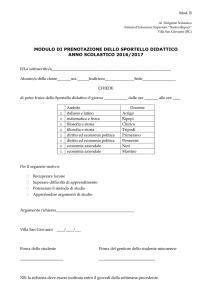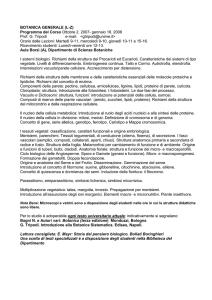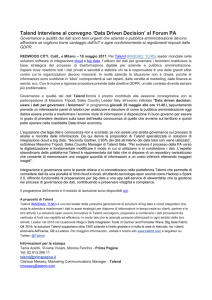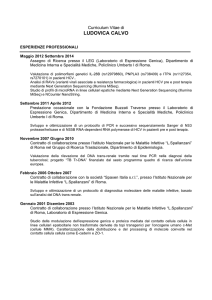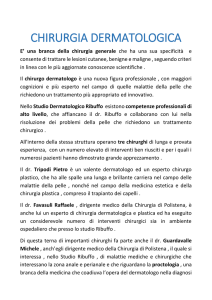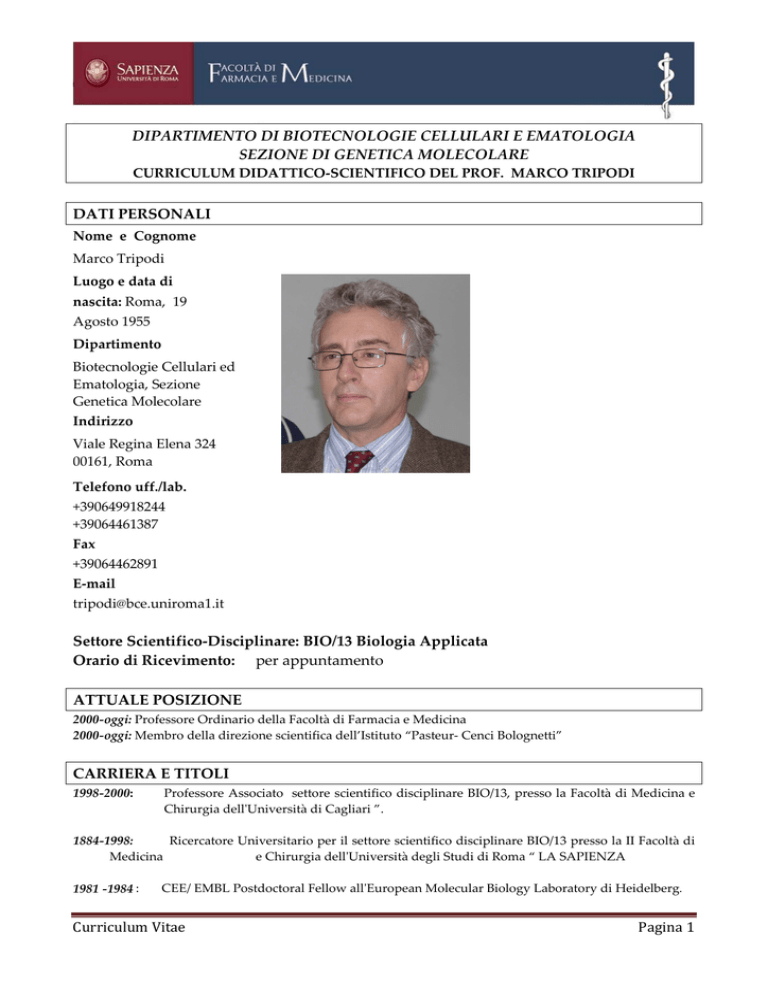
DIPARTIMENTO DI BIOTECNOLOGIE CELLULARI E EMATOLOGIA
SEZIONE DI GENETICA MOLECOLARE
CURRICULUM DIDATTICO-SCIENTIFICO DEL PROF. MARCO TRIPODI
DATI PERSONALI
Nome e Cognome
Marco Tripodi
Luogo e data di
nascita: Roma, 19
Agosto 1955
Dipartimento
Biotecnologie Cellulari ed
Ematologia, Sezione
Genetica Molecolare
Indirizzo
Viale Regina Elena 324
00161, Roma
Telefono uff./lab.
+390649918244
+39064461387
Fax
+39064462891
E-mail
[email protected]
Settore Scientifico-Disciplinare: BIO/13 Biologia Applicata
Orario di Ricevimento: per appuntamento
ATTUALE POSIZIONE
2000-oggi: Professore Ordinario della Facoltà di Farmacia e Medicina
2000-oggi: Membro della direzione scientifica dell’Istituto “Pasteur- Cenci Bolognetti”
CARRIERA E TITOLI
1998-2000:
Professore Associato settore scientifico disciplinare BIO/13, presso la Facoltà di Medicina e
Chirurgia dell'Università di Cagliari ”.
1884-1998:
Ricercatore Universitario per il settore scientifico disciplinare BIO/13 presso la II Facoltà di
Medicina
e Chirurgia dell'Università degli Studi di Roma “ LA SAPIENZA
1981 -1984 :
CEE/ EMBL Postdoctoral Fellow all'European Molecular Biology Laboratory di Heidelberg.
Curriculum Vitae
Pagina 1
1981 -
Laurea con Lode in Scienze Biologiche all'Università "Sapienza" Roma
ATTIVITA’ DIDATTICA
2005-oggi: è coordinatore del Dottorato di ricerca in Scienze Pasteuriane dell'Università Sapienza di Roma.
http://www.bce.uniroma1.it/contents/pagina.aspx?idpagina=95
2000-oggi: coordinatore del corso integrato di Biologia e Genetica del Corso di Laurea Specialistica in Medicina
e Chirurgia della II Facoltà di Medicina dell’Università Sapienza di Roma. Ora Medicina e Psicologia
2000-oggi: coordinatore del II semestre del I anno del Corso di Laurea Specialistica in Medicina e Chirurgia
della II Facoltà di Medicina dell’Università Sapienza di Roma (ora Medicina e Psicologia)
2005-oggi: coordinatore del corso integrato di Basi molecolari delle funzioni cellulari, Laurea Specialistica in
Biotecnologie Mediche Interfacoltà dell’Università Sapienza di Roma.
2005-oggi: coordinatore del I semestre del I anno del Corso di , Laurea Specialistica in Biotecnologie Mediche
Interfacoltà dell’Università Sapienza di Roma.
ATTIVITA’ SCIENTIFICA 2009-2011
Studio dei meccanismi molecolari responsabili:
1-delle Transizioni Epitelio-Mesenchimale (EMT) e, Mesenchimale-Epiteliale (MET) epatocitarie durante lo
sviluppo embrionale e la tumorigenesi;
2- di self-renewal e differenziamento di cellule staminali epatiche.
3- Analisi dei meccanismi patogenetici dell'infezione da HCV e da altri virus emergenti.
4- Analisi proteomica del: differenziamento epatico, metabolismo lipidico ed interazioni virus-ospite.
Attività di revisione
- di articoli scientifici per le seguenti riviste internazionali
“Gastroenterology” “Hepatology”, “Journal of Hepatology”, “Digestive and Liver Disease”, “Proteomic”,
“Cellularand Molecular Life Sciences”, “Cell Death and Differentiation”, “Cell Biology International”,
“Cell Proliferation”, “Gut”, “Journal of Cellular Biochemistry.
-di progetti scientifici per l’European Research Council; per il Miur; per il Ministero della Sanità; per le
Università di Napoli (Federico II ) e di Padova
PUBBLICAZIONI SCIENTIFICHE 15 selezionate( 1988-2007) e 15 recenti (2008-2011)
1.
1988- Dente L., Ruther U., Tripodi M., Wagner E., Cortese R. “Expression of human a-1-acid
glycoprotein genes in cultured cells and in transgenic mice”. Genes and Development 2, 355266.
I.F. 14.79
2.
1990- Tripodi M., Perfumo S., Ali R., Amicone L., Abbott C. Cortese R. “Generation of small
mutation in large genomic fragments by homologous recombination: description of the
technique and examples of its use”. Nucleic Acid Research 18, 6247-6251.
I.F. 6.95
3.
1991- Tripodi M., Abbott C., Vivian N., Cortese R. “Lowell-badge R Disruption of the LF-A1
Curriculum Vitae
Pagina 2
and LF-B1 bindin sites in the humana1- antitrypsin gene has a differential effect during
development in transgenic mice”. EMBO Journal 10, 3177-318
I.F. 10.12
4.
1992- Perfumo S., Amicone L., Colloca S., Giorgio M., Pozzi L., and Tripodi M. “Recognition
Efficenty of the Hepatitis B Virus Polyadenilation Signals Is Tissue Specific in Transgenic
Mice”. Journal of Virology 66, 6819-6823.
I.F. 5.33
5.
1997- Amicone L., Spagnoli F.M., Späth G., Giordano S., Tommasini C., Bernardini S., De Luca
V., Weiss M.C. Comoglio P.M. and Tripodi M. “Transgenic expression in the liver of
truncated Met blocks apoptosis and permits immortalization of hepatocytes”. EMBO J. 16,
495-503.
I.F. 10.12
6.
1997- ColumbanoA., Ledda-Columbano G.M., Pibiri M., R.Piga, H. Shinozuka, De Luca V.,
Cerignoli F. and Tripodi.M. “Increased expression of c-Fos, C-Jun and LRF-1 is not required
for in vivo priming of hepatocytes by the mitogen TCPOBOP”. Oncogene 14, 857-863. I.F.
6.44
7. 1998- Aiuti A., Cicchini C., Bernardini S., Fedele G., Amicone L., Fantoni A. and Tripodi M..
“Hematopoietic support and cytokine expression of fetal and newborn- derived mouse stable
hepatocyte cell lines”. Hepatology 28, 1645-1654.
I.F 10.73
8. 1998- Maione D., Di Carlo E., Li W., Musiani P., Modesti A., Peters M., Rose-Jhon S., Della
Rocca C., Tripodi M., Lazzaro D., Taub R., Savino R. and Ciliberto G. “Coexpression of IL-6
and soluble IL-6R causes nodullar regenerative hyperplasia and adenomas in the liver”.
EMBO J. 17, 5588-5597. I.F. 8.66
9. 1998- Spagnoli F.M., Amicone L., Tripodi M. and C. Weiss M. “Identification of a bipotential
precursor cell in hepatic cell lines derived from transgenic mice expressing cyto-Met in the
liver”. Journal Cell Biology 143, 1101-1112.
I.F. 9.59
10. 2002- Amicone L., Terradillos O., Calvo L., Costabile B., Cicchini C., Della Rocca C., Lozupone
F., Piacentini M., Buendia M. and Tripodi M. “Synergy between truncated c-Met (cyto-Met)
and c-Myc in liver oncogenesis: importance of TGF-B signalling in the control liver
homeostasis and transformation”. Oncogene 21,1335-1345.
I.F. 6.44
11. 2002- Ledda-Columbano G., Pibiri M., Concas D., Cossu C., Tripodi M. and Columbano A.
“Loss of Cyclin D1 Does Not Inhibit the Proliferative Response of Mouse Liver to Mitogenic
Stimuli”. Hepatology Vol 36, Pp. 1098-1105.
I.F. 10.73
12. 2003- Blindenbacher A., Duong F., Hunziker L., Stutvoet S. T., Wang X., Terracciano L., Alonzi
T., Moradpour D., Blum H. E., Tripodi M., La Monica N., and Markus H. Heim. “Expression
of Hepatitis C Virus Proteins InhibitsInterferon Alpha Signaling in the Liver of Transgenic
Mice”. Gastroenterology 124, 1465-1475.
I.F. 11.67
13. 2004- Duong F.H.T., Filipowicz M., Tripodi M., La Monica N., and Markus H. Heim.
“Hepatitis C Virus Inhibits Interferon Signaling through Upregulation of Protein Phosphatase
2A ". Gastroenterology. 126, 263-277.
I.F. 11.67
Curriculum Vitae
Pagina 3
14. 2004- V. Bordoni, T. Alonzi, C. Agrati, F. Poccia, G. Borsellino, G.M. Fimia, M. Piacentini, A.
Fantoni and M. Tripodi. “Murine hepatocyte cell lines (MMH) promote the expansion and the
differentiation of NK cells from stem cell precursors”. Hepatology 39,6 , 1508-1516. I.F. 10.73
15. 2007- V. Bordoni, T. Alonzi, L. Zanetta, D. Khouri, A. Conti, M. Corazzari, F. Bertolini,
P.Antoniotti, G. Pisani, F. Tognoli, E. Dejana and M. Tripodi. “Hepatocyte conditioned
medium sustains long term culture of CD34+ derived adult human hemangioblasts and
induces their differentiation to endothelial cells”. Hepatology 2007 May; 45(5):1218-1228.
I.F. 10.73
2008-2011
1.
2008- Cicchini C., Laudadio I., Citarella F., Corazzari M., Steindler C., Conigliaro A., Fantoni
A., Amicone L., M. Tripodi. “TGFβ-induced EMT requires Focal Adhesion Kinase (FAK)
signalling”. Experimental Cell Research. 2008 Jan 1;314(1):143-52. Epub 2007 Sep 18. I.F
3.69
2.
2008- Conigliaro A., Colletti M., Cicchini C., Guerra M.T., Manfredini R., Zini R., Bordoni V.,
Siepi F., Leopizzi M., Tripodi M., L. Amicone. “Isolation and characterization of murine liver
resident stem cell”. Cell Death And Differentiation. 2008 Jan;15(1):123-33.
I.F. 8.25
3.
2008- Zimmermann M., Flechsig C., La Monica N., Tripodi M., Adler G., And N. Dikopoulos.
„Hepatitis C virus core protein impairs in vitro priming of specific T cell responses by
dendritic cells and hepatocytes”. Journal of Hepatology. 2008 Jan; 48(1):51-60. I.F. 6.64
4.
2008- Nolan T., Cecere G., Chiofalo G., Mancone C., Alonzi T., Tripodi M., Catalanotto C.,
Cogoni C. “The RNA-dependent RNA polymerase essential for post-transcriptional gene
silencing in Neurospora crassa interacts with replication protein A”. Nucleic acid research.
2008 Feb; 36(2): 532-8. I.F. 6.95
2008- Notari S., C. Mancone, T. Alonzi, M. Tripodi, P. Narciso, and P. Ascenzi. J
Chromatography B. Submitted. “Determination of abacavir, amprenavir, didanosine,
efavirenz, nevirapine, and stavudine concentration in human plasma by MALDI-TOF/TOF”. J
Chromatogr B Analyt Technol Biomed Life Sci. 2008 Mar 1;863(2):249-57. I.F. 2.93
5.
6.
2008- Alonzi T., Mancone C., Amicone L., Tripodi M. “Elucidation of lipoprotein particles
structure by proteomic analysis”. Expert Rev Proteomics. 2008 Feb; 5(1):91-104. I.F. 07 3.6
7.
2008- Marchetti A., Colletti M., Cozzolino A.M., Steindler C, Lunadei M., Mancone C., Tripodi
M.: “ERK5/MAPK is activated by TGFbeta in hepatocytes and required for the GSK3betamediated Snail protein stabilization”. Cell Signal. 2008 Nov;20(11):2113-8. I.F. 4.14
8.
2009- Agrati C., Cimini E., Sacchi A.,Bordoni V., Gioia C., Casetti R. , Turchi F. , Tripodi M.
and Martini F. “Activated Vg9Vd2 T cells trigger granulocytes functions via MCP-2 release"
The Journal of Immunology.Jan 1;182(1):522-9. I.F. 6.06
9.
.2009- Wegert M, La Monica N., Tripodi M. , Adler G., Dikopoulos N..” Impaired Interferon
Curriculum Vitae
Pagina 4
Type I Signalling in the Liver Modulates the Hepatic Acute Phase Response in Hepatitis C
Virus Transgenic Mice” Journal of Hepatology. 2009 Aug;51(2):271-8. I.F. 6.64
10. Colletti M, Cicchini C., Conigliaro A., Santangelo L., Alonzi T. , Pasquini E., Tripodi M,
Amicone L. “Convergence of Wnt signaling on the HNF4a-driven transcription in controlling
liver zonation” Gastroenterology. 2009 Aug;137(2):660-72. I.F. 12.6
11. 2009-Rossi M.N., Carbone M., Mostocotto C., Mancone C., Tripodi M., Maione R. and Amati
P.: “Mitochondrial localization of PARP-1 requires interaction with mitofilin and is involved
in the maintenance of mitochondrial dna integrity”. J Biol Chem Nov 13;284(46):31616-24..
I.F. 5,52
12. 2010- Mancone C., Conti B., Amicone L., Bordoni V., Cicchini C., Calvo L., Basulto A., Fimia
G.M., Tripodi M. and Alonzi T.: “Proteomic analysis reveals a major role of contact inhibition
in the execution of hepatocyte terminal differentiation”. J of Hepatology, 2010 Feb;52(2):23443I I.F. 7,05
13. 2010- Notari S, Mancone C, Sergi M, Gullotta F, Bevilacqua N, Tempestilli M, Urso R, Lauria
FN, Pucillo LP, Tripodi M, Ascenzi Determination of antituberculosis drug concentration in
human plasma by MALDI-TOF/TOF. IUBMB Life. 2010 2010 May;62(5):387-93 I.F. 2.34
14. 2010-Mancone C., Steindler C., Santangelo L., Simonte G., , Vlassi C., Longo M.A., D’Offizi G.,
Di Giacomo C., Pucillo L.P., Amicone L., Tripodi M and Alonzi T.: “Hepatitis C Virus
production requires apolipoprotein A-I and affects its association to the nascent low-density
lipoproteins”. GUT, Mar;60(3):378-86 I.F. 9.3
15. 2011- Santangelo L., Marchetti A., Cicchini C, Conigliaro A., Conti B. , Mancone C, Alonzi T.,
Amicone L., Tripodi M.: “Hepatocyte identity implies stable repression of the mesenchymal
program: a novel role for hepatocyte nuclear factor 4α”. Hepatology Jun;53(6):2063-74 I.F.
10.8
Curriculum Vitae
Pagina 5

![Da: [mailto:] Per conto](http://s1.studylibit.com/store/data/000666364_1-1fe652dd826c3f2f8dae16c9a89515e4-300x300.png)
